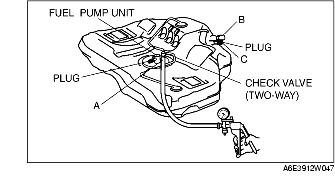FUEL TANK INSPECTION [LF, L3]
id0114008032a4
-
Caution
-
• Disconnecting/connecting the quick release connector without cleaning it may possibly cause damage to the fuel pipe and quick release connector. Always clean the quick release connector joint area before disconnecting/connecting using a cloth or soft brush, and make sure that it is free of foreign material.
-
Note
-
• This inspection is for two rollover valves integrated in the fuel tank.
1. Disconnect the plastic fuel hose and the fuel pump unit connector. (See FUEL PUMP UNIT REMOVAL/INSTALLATION [LF, L3].)
2. Remove the fuel tank with the fuel pump unit. (See FUEL TANK REMOVAL/INSTALLATION [LF, L3].)
3. Plug the fuel pipe of the fuel pump unit.
4. Connect the pump to port A.
5. Level the fuel tank.
6. Apply pressure of -2.0 kpa {-34 mmHg, -1.3 inHg} to port A.
-
(1) Plug port C and verify there is vacuum from port B.
-
• If there is no vacuum, replace the fuel tank.
7. Apply pressure of +5.9 kPa {+44 mmHg, +1.7 inHg} to port A.
-
• If there is no airflow, replace the fuel tank.
-
• If there is airflow, proceed to next step.
8. Turn the fuel tank upside-down and apply pressure of -2.0 kPa {-15 mmHg, -0.6 inHg} to port A.
-
(1) Plug port C and verify there is no vacuum from port B.

-
• If there is vacuum, replace the fuel tank.

